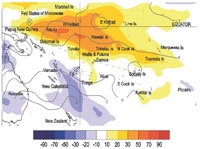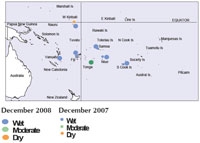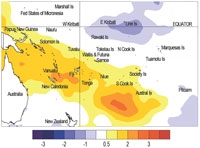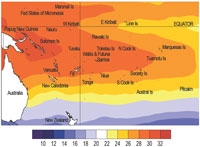Climate developments in December 2008

The South Pacific Convergence Zone (SPCZ) activity was displaced south and west of normal during December, and less consolidated than last month. A region of enhanced rainfall was observed during December 2008 over southern Papua New Guinea and northeast Australia, and to the southeast of New Caledonia. Suppressed convection intensified during the month to the south of the Equator, and encompassed the region northeast of the Solomon Islands, Nauru, and Western Kiribati and extended across the southwest Pacific to central French Polynesia. The regional circulation for the month was characterised by more frequent high pressure across the South Pacific from east of Papua New Guinea to the Society Islands; and lower than normal pressure near northern New Zealand and Eastern Kiribati.
Rainfall was near normal or below normal for many countries in the southwest Pacific in December 2008. The exception occurred in a swath that extended from southern Vanuatu and west of Tonga southward through the Kermadec Islands, and enhanced rainfall was also localised in northern and central Australia. Lower than normal rainfall was recorded at many stations in French Polynesia, with Tahiti in the Society Islands receiving 106 mm of rainfall (30% of normal). Elsewhere in the eastern half of the southwest Pacific, the stations in the Tuamotu archipelago and the Austral Islands all recorded normal or below normal rainfall, except Tubuai, which received 354 mm (195% of normal).
Many stations in New Caledonia received well below normal rainfall (30–60%) during December. Vanuatu experienced a relatively dry month, with the northern part of the country recording near or below normal rainfall. The Solomon Islands also had a relatively dry month receiving 70–90% of normal rainfall, except at Auki, which received 456 mm of rain (159% of normal).
In Fiji, higher than normal rainfall occurred at Nadi Airport (271 mm; 152% of normal). In Samoa, abundant rainfall continued to fall in December, except at Maota. A regional high monthly rainfall total was recorded at Afiamalu, which received 751mm (129% of normal). In the western southwest Pacific, rainfall totals were near to above normal in central and eastern Australia.
| Island Group | Location | Rainfall (mm) | % of average | Comments |
|---|---|---|---|---|
| Southern Cook Islands | Rarotonga Airport | 471 | 251 | Record high |
| French Polynesia | Tubuai | 354 | 195 | Very high |
| Samoa | Afiamalu | 751 | 129 | Highest monthly total in the region |
| Tonga | Lupepau’u | 27 | 21 | Very low |
| Eastern Kiribati | Kanton | 1 | 1 | Very low |
Soil moisture in December 2008

Estimates of soil moisture shown in the map (right) are based on monthly rainfall for one station in each country. Currently there are not many sites in the water balance model, but it is planned to include more stations in the future.
The information displayed is based on a simple water balance technique to determine soil moisture levels. Addition of moisture to available water already in the soil comes from rainfall, and losses via evapotranspiration. Monthly rainfall and evapotranspiration are used to determine the soil moisture level and its changes. Please note that these soil moisture calculations were made at the end of the month, and for practical purposes, generalisations were made about the available water capacity of the soils at each site.
Nadi (Fiji), Hanan (Niue), Port Vila (Vanuatu), Rarotonga (Southern Cook Islands), and Apia (Samoa) project moist (at or near field capacity) soil moisture conditions. Soils are moderate for the time of year at Nuku’alofa (Tonga).
El Niño/Southern Oscillation (ENSO)


During December, La Niña conditions were re–established in the equatorial Pacific Ocean, with the tropical Pacific atmosphere exhibiting moderate to strong La Niña characteristics. The SOI has remained persistently positive with a December value of +1.3 (OND mean +1.4), and easterly trade winds have remained strong during December about and west of the Date Line.
SST anomalies in December were below average across the equatorial Pacific: The NINO3 anomaly for December was –0.2°C (3–month mean +0.0°C), and the NINO4 anomaly was –0.5°C (OND mean 0.2°C). A warmer ‘horseshoe’ has also formed in the subtropics. Equatorial subsurface temperature anomalies are now below average east of the Date Line, with a –4°C anomaly centred near 140°W below 100 m.
Tropical Pacific precipitation patterns continue a La Niña signal, with the TRMM ENSO precipitation index at –1.3 for December. OLR anomalies show extremely suppressed equatorial convection about and west of the Date Line for December as a whole, with enhanced convection over the maritime continent and northern Australia. A convective pulse associated with the MJO was present east of Indonesia during early January, but this is predicted to dissipate by mid January as the convective region approaches the Date Line. Thus, the evidence suggests a redevelopment of a La Niña.
Several climate models assessed by NIWA indicate cool SST anomalies for the late summer period and La Niña conditions. However, the majority indicate neutral conditions developing during autumn 2009. The NCEP draft discussion of 6 January indicates La Niña conditions are likely to continue into the Northern Hemisphere spring of 2009. The IRI summary of 17 December projects a 50–55% probability of ENSO-neutral conditions persisting over the coming season, and 45–50% for weak La Niña conditions.
Tropical Cyclone Guidance
Conditions in the tropical Pacific are likely to affect the chances of tropical cyclone (TC) activity for several countries between January and May 2009. There is an increased risk of TC occurrence for countries west of the Date Line, including Vanuatu, the Solomon Islands, and New Zealand, and a slight risk increase for New Caledonia. Reduced risk is expected for Samoa, Tonga, and Niue. For more information go to http://www.niwascience.co.nz/news/mr/2009/2009-01-09
Forecast validation: October to December 2008
A large region of suppressed convection was forecast to encompass the Solomon Islands, and a region extending southeast from Tuvalu to Pitcairn Island, including Tokelau, Wallis & Futuna, Samoa, the Northern Cook Islands, and most of French Polynesia, with average or below, or below average rainfall for those countries. Enhanced convection and above average rainfall was forecast for Papua New Guine, Vanuatu, Eastern Kiribati, Tonga, and the Southern Cook Islands. Near or above average rainfall was forecast for Fiji, Niue, New Caledonia. No precipitation guidance was offered for the Austral Islands or the Society Islands.
The rainfall outlook for the October–December 2008 period was very good compared to our forecast, although this is calculated for 17 island groups (two islands had a forecast of ‘climatology’, which is unscoreable and two did not report values).The global station ‘hit’ rate was 71%, 7% higher than average for forecasts made during October and 10% higher than the average for all months combined. Rainfall totals were slightly overestimated for parts of Samoa, Vanuatu, the Southern Cook Islands, and Fiji.
Forecast statistics compiled over the last nine years indicate the multi-model ensemble strike rate will continue to have good skill throughout the summer.
